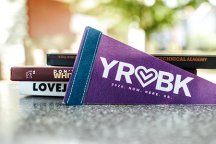How color impacts your yearbook design
Pick a color, any color. Visual choices make a dramatic impact, especially when selecting color in the yearbook.
Find your hue and you set the mood for the book. Deep greens and browns give an earthy vibe, neon colors scream energy and fun, pastels suggest a sweet, whimsical feel. Color evokes emotions, making the decisions integral to the look and feel of a yearbook.
How do you decide?
First, contemplate the tone of the yearbook. Think about the personality or the mood you want to conjure up with this year’s book. Bold? Playful? Classic? Elegant? The color choices should reflect the tone words.
The Jostens Color Guide is a fabulous place to research color. Located in the Digital Classroom and your yearbook kit, this 56-page guide provides plenty of color inspiration. There are 20 families with tone words, chosen colors and suggested combinations. Each palette of 16 colors is organized by bright, warm and muted tones.

In addition to the family color palettes, the guide provides helpful information about applying tint and transparency, as well as showcasing all the color swatches in one place (see the main photo above). Black and white type is printed on each swatch for readability comparisons.
Color tip: Cut out swatches to make it easier to compare colors or add them to a mood board.
Another helpful note: Jostens colors have two parts to their naming. Each swatch begins with two letters in all caps. This represents the family, the tonal words in the earlier palettes (e.g. IN for intense, TR for traditional). Then, the swatch color name follows (e.g. “Peacock”). So, IN Peacock is a deep green-blue hue in the Intense family.
Choose your color strategy
Think critically about how you want to utilize color in your yearbook. There are two common strategies:
-
Use a specific color palette throughout the book.
For this common strategy, the staff chooses specific colors to use throughout the book. Only the chosen colors are used, establishing visual consistency from page to page. Staffs choose colors that reflect the mood or personality of the book.
The hues are also purposely chosen to complement each other as well as the typography choices. Dos Pueblos High School opted for a pastel color palette that sparked a fun vibe. This is emphasized by the handwriting font, the messy cutout shadows and the pastel color blocks used for sidebars.

Dos Pueblos High School [CA]
With a specific color palette throughout the book, staffs might also designate specific color(s) for each section. Often limited to one or two colors, we would only see the appointed hue(s) used in typography and graphics in that section. For example, the student life section might use a shade of orange while the sports section features blue. Or a summer section might utilize yellow and orange while the spring section includes pink and green. This is another way to establish consistency for each section of the book.
-
Pull color(s) that pop from photos on each spread.
Another strategy focuses on color already on the page. Staffers utilize spot color, essentially pulling a distinctive color from a photo or photos. This is typically done from the dominant photo where a color might have a striking presence, especially given the size of the main image. Using spot color provides cohesion with the visual look of the spread, connecting color elements on the spread to the photo(s).
Bryant High School pulled color from photos throughout their book, featuring the spot color throughout typography on the pages. In the below example, they pulled the bold pink color from the opponent’s soccer jersey. That spot color was then featured in the main headline as well as in smaller sidebar headlines. They even incorporated the pink hue in the caption lead-ins and the folio.

Bryant High School [AR]
A third option
When it comes to color decisions, staffs can also opt for a hybrid approach, utilizing more than one color strategy. They might feature the designated color palette for the theme pages, but rely on pull color for other layouts. This is a smart way to combat color challenges, especially in sports sections when the school colors might clash with the palette choices.
Color choices make a dramatic impact on the look and feel of a yearbook. Color evokes emotion, enhancing the mood and personality set by the theme. Whether you create a specific color palette, use pull color or go for a hybrid approach, your color choices are sure to grab readers.
WRITTEN BY JOSTENS CREATIVE TEAM


